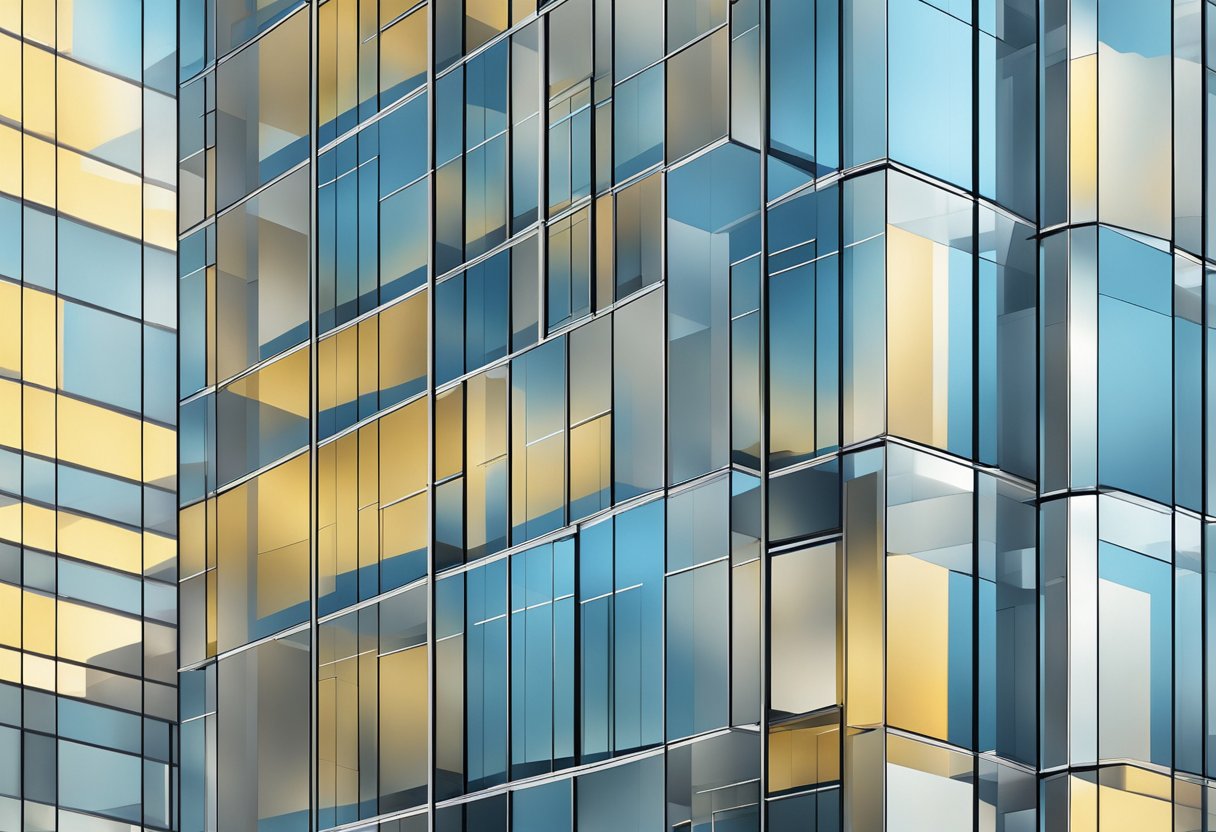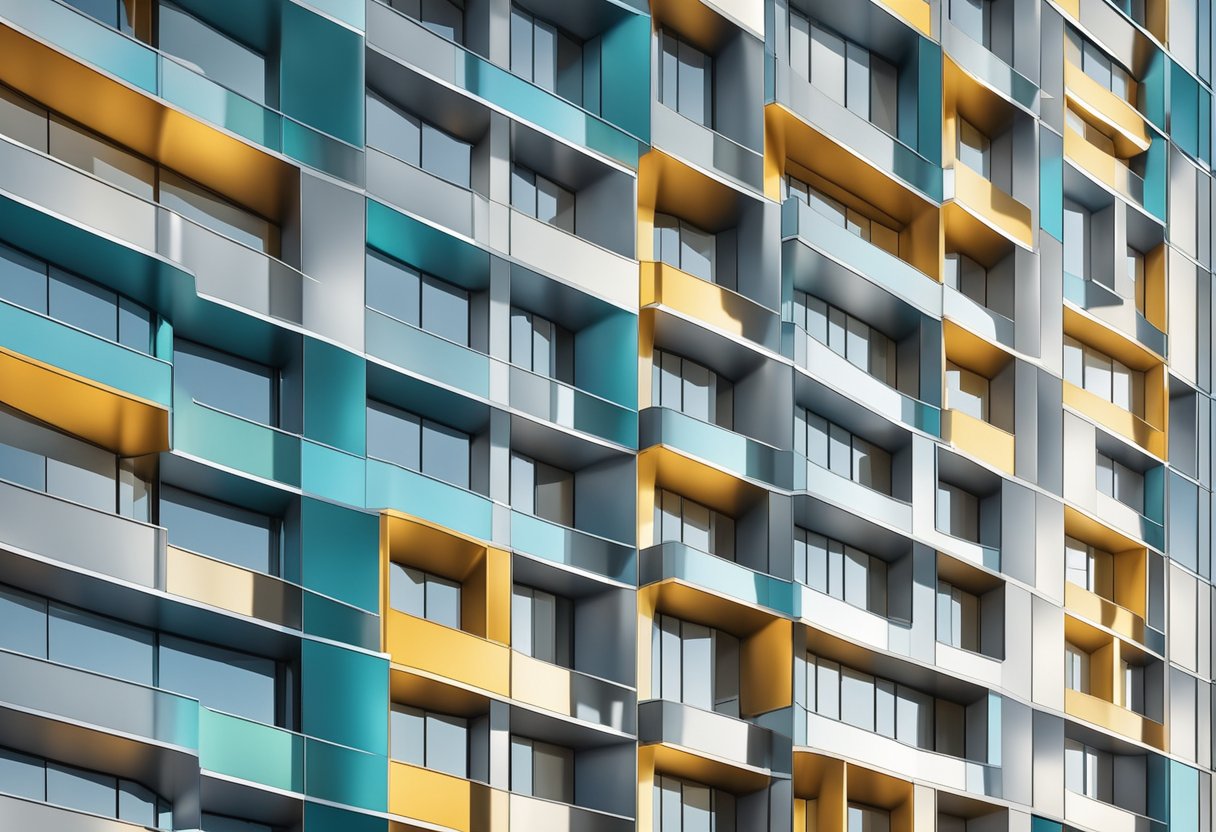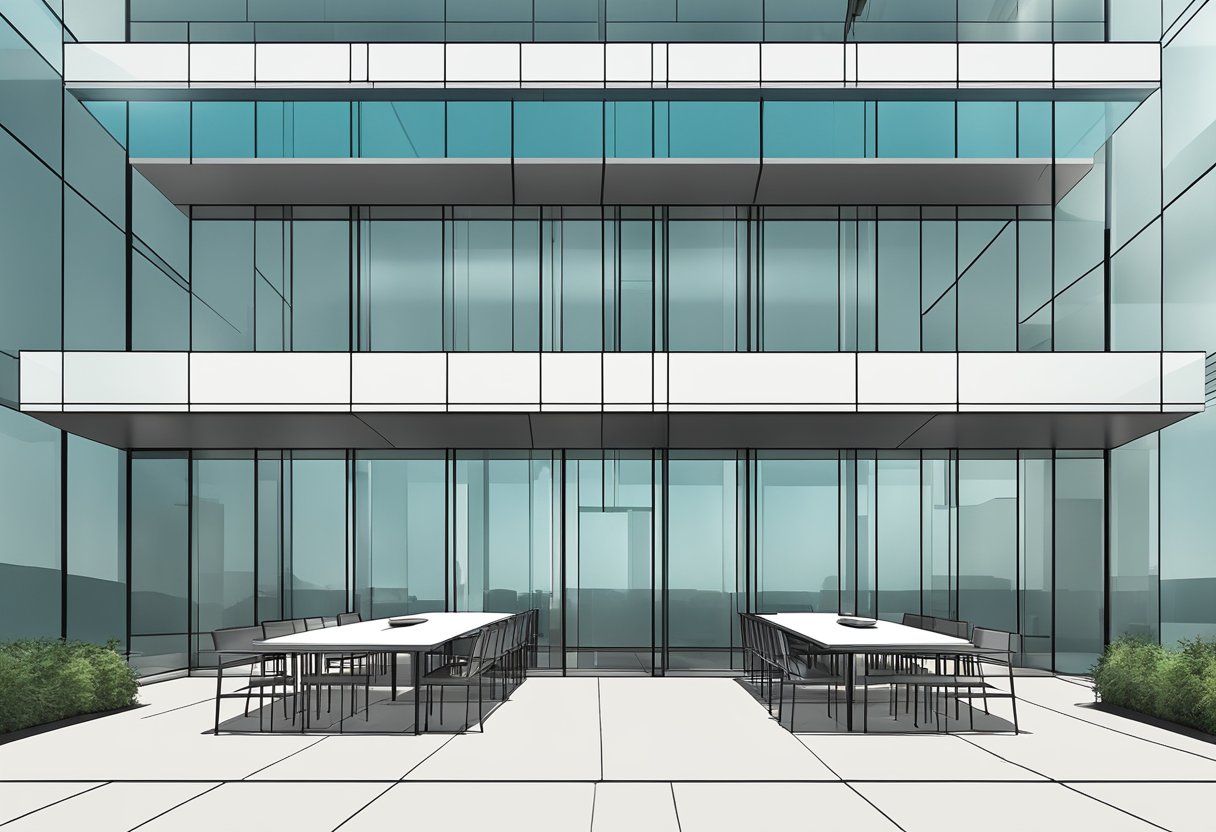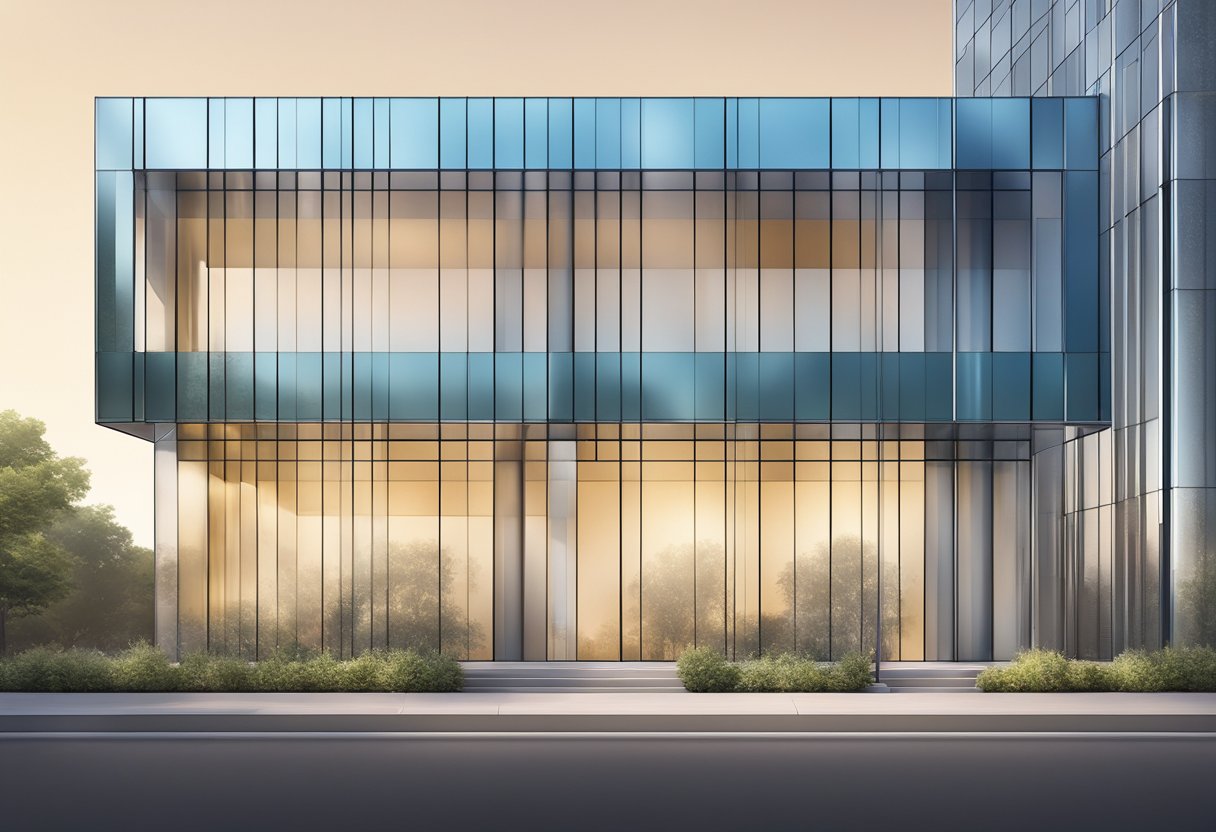Aluminum curtain wall panels are a popular choice for modern architecture due to their sleek appearance and durability. These panels are typically made of lightweight aluminum and are used to cover the exterior of a building. They are designed to provide a barrier against weather elements while also enhancing the building’s aesthetic appeal.

One of the main benefits of aluminum curtain wall panels is their versatility. They can be customized to fit any building design, making them a popular choice for architects and builders. Additionally, these panels are easy to install and require minimal maintenance, making them a cost-effective option for building owners.
Another advantage of aluminum curtain wall panels is their energy efficiency. They can be designed to include insulation, which helps to reduce energy costs by keeping the building warm in the winter and cool in the summer. This feature also helps to reduce the building’s carbon footprint, making it a more environmentally friendly option.
Fundamentals of Aluminum Curtain Wall Panels

Aluminum curtain wall panels are a popular choice for modern architectural designs. They are lightweight, durable, and provide an aesthetically pleasing appearance to buildings. In this section, we will discuss the fundamentals of aluminum curtain wall panels.
Material
Aluminum is the primary material used to manufacture curtain wall panels. It is a non-corrosive metal that can withstand harsh weather conditions. The aluminum panels are coated with a protective layer that prevents corrosion and fading due to UV rays. The thickness of the aluminum panel varies based on the design and requirements of the building.
Design
The design of the aluminum curtain wall panel is critical to its performance. The panel should be designed to withstand wind loads, thermal expansion, and contraction. The design should also allow for proper drainage to prevent water from accumulating on the panel’s surface.
Installation
The installation of aluminum curtain wall panels requires skilled professionals. The panels are attached to the building’s structure using a framing system. The framing system should be designed to accommodate the panel’s weight and provide proper support. The installation process should also ensure that the panels are properly sealed to prevent water infiltration.
In summary, aluminum curtain wall panels are an excellent choice for modern architectural designs. They are durable, lightweight, and provide an aesthetically pleasing appearance to buildings. The material, design, and installation of the panels are critical to their performance and should be done by skilled professionals.
Design Considerations

When it comes to designing aluminum curtain wall panels, there are several important considerations to keep in mind. These considerations include aesthetic appeal, structural integrity, and thermal performance.
Aesthetic Appeal
One of the primary benefits of using aluminum curtain wall panels is their versatility in design. These panels can be customized to fit nearly any aesthetic preference, ranging from sleek and modern to more traditional styles.
Designers can choose from a wide range of finishes, including anodized, painted, or powder-coated options, to achieve the desired look. Additionally, aluminum panels can be cut and shaped into various sizes and shapes, allowing for even more design flexibility.
Structural Integrity
Another critical consideration when designing aluminum curtain wall panels is their structural integrity. These panels must be able to withstand wind, rain, and other environmental factors without compromising the building’s structural integrity.
To ensure their strength and durability, aluminum curtain wall panels are typically designed with a series of interlocking joints and connections. These connections, along with the use of high-quality aluminum alloys, help to ensure that the panels remain securely in place over time.
Thermal Performance
Finally, designers must consider the thermal performance of aluminum curtain wall panels. These panels must be able to provide adequate insulation to help regulate the building’s temperature and reduce energy costs.
To achieve optimal thermal performance, designers can choose from a variety of insulation options, including mineral wool, polyurethane foam, or polystyrene. Additionally, the use of thermally broken aluminum framing can help to prevent heat transfer and improve overall energy efficiency.
Overall, when designing aluminum curtain wall panels, it is essential to keep these key considerations in mind to ensure that the final product meets both aesthetic and functional requirements.
Materials and Composition

Aluminum Alloys
Aluminum curtain wall panels are made of high-quality aluminum alloys, which are known for their strength, durability, and corrosion resistance. The most commonly used aluminum alloys for curtain wall panels are 6061 and 6063. These alloys are lightweight and have excellent thermal conductivity, making them ideal for use in high-performance building envelopes.
Glass and Glazing Options
Glass is an essential component of curtain wall systems, and there are various options available for glass and glazing. The most common types of glass used in curtain walls are tempered, laminated, and insulated glass. Tempered glass is heat-treated to increase its strength and durability, making it resistant to breakage. Laminated glass consists of two or more glass panels bonded together with a layer of polyvinyl butyral (PVB) interlayer, providing additional safety and security. Insulated glass units (IGUs) are made up of two or more glass panels separated by an air or gas-filled space, providing superior thermal insulation.
Insulation and Spandrel Panels
Insulation and spandrel panels are essential components of curtain wall systems, providing thermal insulation and aesthetic appeal. Insulation panels are typically made of mineral wool or foam, providing excellent thermal insulation and soundproofing. Spandrel panels are non-vision panels that are used to conceal the building’s structural elements and provide a uniform appearance to the curtain wall system. These panels are available in a wide range of colors and finishes, allowing architects and designers to create unique and visually appealing building facades.
In summary, aluminum curtain wall panels are made of high-quality aluminum alloys, tempered, laminated, or insulated glass, insulation panels, and spandrel panels. These materials work together to create a high-performance building envelope that provides superior thermal insulation, soundproofing, and aesthetic appeal.
Manufacturing Processes
Extrusion
Extrusion is the primary process used to manufacture aluminum curtain wall panels. It involves heating aluminum billets to a specific temperature and then forcing the molten metal through a die to create a desired shape. The extrusion process allows for the creation of complex shapes, including those with multiple bends and curves.
Fabrication
Once the extruded aluminum profiles have been created, they are cut and machined to the correct size and shape for the specific project. Fabrication may include drilling, punching, and cutting to create openings for windows and doors.
Assembly
The final step in the manufacturing process is assembly. This involves attaching the aluminum panels to a support system and installing any necessary hardware, such as brackets and clips. The panels may be attached using various methods, including adhesive bonding, mechanical fastening, or a combination of both.
Overall, the manufacturing process for aluminum curtain wall panels requires precision and attention to detail. The extrusion process allows for the creation of complex shapes, while fabrication and assembly ensure that the panels are tailored to the specific needs of the project.
Installation Techniques
Anchoring Systems
Aluminum curtain wall panels are typically anchored to the building structure using a variety of systems. The most common anchoring systems include face-sealed, pressure-equalized, and rainscreen systems. Each system has its own advantages and disadvantages.
Face-sealed systems rely on a continuous sealant to prevent water infiltration. Pressure-equalized systems use a combination of weep holes and pressure differentials to prevent water infiltration. Rainscreen systems use a separate weather-resistant barrier to prevent water infiltration.
The choice of anchoring system will depend on the specific project requirements, including the building design, location, and climate.
Sequencing and Erection
Proper sequencing and erection are critical to the successful installation of aluminum curtain wall panels. The installation process typically involves the following steps:
- Layout and measurement
- Anchor installation
- Panel installation
- Joint treatment
- Field testing
It is important to follow the manufacturer’s installation instructions and industry best practices to ensure a quality installation.
Field Testing
Field testing is an important part of the installation process to ensure that the curtain wall system is performing as intended. Field testing typically includes water infiltration testing and air leakage testing.
Water infiltration testing involves spraying water on the exterior of the curtain wall system to simulate rain and checking for water infiltration on the interior. Air leakage testing involves pressurizing the interior of the building and checking for air leaks in the curtain wall system.
Proper field testing can help identify any issues with the installation or design of the curtain wall system and ensure that it meets the performance requirements for the building.
Performance Standards
Building Codes
Aluminum curtain wall panels must meet certain building codes to ensure their safety and reliability. These codes vary by jurisdiction, but typically include requirements for wind resistance, fire safety, and structural integrity. Curtain wall panels made from aluminum are known for their ability to withstand extreme weather conditions, making them a popular choice for modern buildings.
Energy Efficiency Ratings
In addition to meeting building codes, aluminum curtain wall panels can also be rated for energy efficiency. These ratings are based on factors such as the panel’s insulation properties, solar heat gain coefficient, and visible transmittance. By choosing curtain wall panels with high energy efficiency ratings, building owners can reduce their energy consumption and save money on heating and cooling costs.
Water and Air Infiltration
Another important performance standard for aluminum curtain wall panels is their ability to prevent water and air infiltration. This is particularly important in areas with heavy rainfall or high winds. Curtain wall panels should be tested for their resistance to water penetration and air leakage to ensure that they provide adequate protection against the elements.
In summary, aluminum curtain wall panels must meet strict performance standards to ensure their safety, reliability, and energy efficiency. Building codes, energy efficiency ratings, and water and air infiltration tests are all important factors to consider when selecting curtain wall panels for a new construction project.
Sustainability and Environmental Impact
Recyclability
One of the most significant advantages of aluminum curtain wall panels is their recyclability. Aluminum is a highly recyclable material, and recycling it requires only a fraction of the energy needed to produce new aluminum. This makes aluminum curtain wall panels an environmentally sustainable choice for building facades.
Moreover, recycling aluminum curtain wall panels reduces the amount of waste that ends up in landfills. As a result, it helps to reduce the environmental impact of construction and demolition activities.
Life Cycle Assessment
Aluminum curtain wall panels have a low environmental impact throughout their life cycle. A life cycle assessment (LCA) is a method used to evaluate the environmental impact of a product from cradle to grave. An LCA of aluminum curtain wall panels has shown that they have a low impact on the environment in terms of greenhouse gas emissions, energy consumption, and resource depletion.
The LCA of aluminum curtain wall panels takes into account the entire life cycle of the product, from the extraction of raw materials to the end-of-life stage. It includes the production of aluminum, the manufacturing of the curtain wall panels, transportation, installation, use, maintenance, and disposal.
Overall, the sustainability and environmental impact of aluminum curtain wall panels make them an attractive choice for architects, builders, and property owners who are looking for environmentally sustainable building materials.
Maintenance and Durability
Cleaning Procedures
Aluminum curtain wall panels are low maintenance, but they still require periodic cleaning to maintain their appearance. The frequency of cleaning depends on the location of the building and the level of pollution in the surrounding area. In general, it is recommended to clean the panels at least once a year.
To clean the panels, a mild detergent solution and a soft-bristled brush should be used. Harsh chemicals or abrasive materials should be avoided, as they can damage the surface of the panel. The panels should be rinsed thoroughly with clean water after cleaning to remove any residue.
Repair and Replacement
Aluminum curtain wall panels are durable and long-lasting, but they may require repairs or replacement over time. Damage to the panels can occur due to extreme weather conditions, impact, or improper installation.
If damage occurs, it is important to address it promptly to prevent further damage and maintain the integrity of the building envelope. Repairs should be carried out by a qualified professional to ensure that they are done correctly and safely.
In some cases, it may be necessary to replace the damaged panels. Replacement panels should match the original panels in color, finish, and texture to ensure a uniform appearance. It is important to work with a reputable manufacturer or supplier to ensure that the replacement panels meet the necessary standards and specifications.
Overall, proper maintenance and prompt repairs can help extend the lifespan of aluminum curtain wall panels and maintain the appearance and functionality of the building envelope.
Innovations in Curtain Wall Technology
Smart Glass Technologies
In recent years, there have been significant advancements in smart glass technologies that have revolutionized the way curtain walls are designed and used. Smart glass, also known as switchable glass, is a type of glass that can change its properties in response to external stimuli such as light, heat, or electricity. This technology has been integrated into curtain wall systems to enhance their functionality and energy efficiency.
Smart glass curtain walls can be programmed to automatically adjust their tint or opacity in response to changing weather conditions, reducing the need for artificial lighting and air conditioning. This not only saves energy but also provides a more comfortable and productive environment for occupants.
Modular Systems
Modular curtain wall systems have also emerged as a game-changer in the field of curtain wall technology. These systems are designed to be prefabricated off-site and then assembled on-site, reducing construction time and costs significantly.
Modular systems are versatile and can be customized to fit any building design or shape. They are also easy to maintain and upgrade, making them a cost-effective solution for building owners and developers.
In addition to their cost and time-saving benefits, modular systems also offer improved safety and quality control, as they are manufactured in a controlled environment and undergo rigorous testing before installation.
Overall, these innovations in curtain wall technology have opened up new possibilities for architects, engineers, and developers to create more sustainable, efficient, and aesthetically pleasing buildings.
Case Studies
Notable Projects
Aluminum curtain wall panels have been used in several notable projects around the world. One such project is the Burj Khalifa in Dubai, which is currently the tallest building in the world. The building’s façade features over 24,000 aluminum panels that were designed to withstand the extreme weather conditions in the region. Another notable project is the Petronas Towers in Kuala Lumpur, Malaysia, which were once the tallest buildings in the world. The towers feature over 80,000 aluminum panels that were specifically designed to reflect the surrounding environment.
Failures and Lessons Learned
While aluminum curtain wall panel have been used successfully in many projects, there have also been failures and lessons learned. One example is the Grenfell Tower fire in London, which resulted in the deaths of 72 people. The tower’s façade featured aluminum composite panels that were not fire-resistant, which allowed the fire to spread rapidly. As a result, many countries have since implemented stricter regulations on the use of aluminum composite panels in building construction.
Another example is the Citicorp Center in New York City, which was built in the 1970s. The building’s original design featured a unique structural system that was supported by four columns located at the corners of the building. However, it was later discovered that the building was vulnerable to high winds due to a flaw in the design. To fix the issue, the building’s engineers had to implement a series of retrofit measures, including the addition of aluminum panels to the building’s façade to help stabilize it.
Overall, while aluminum curtain wall panel have been used successfully in many projects, it is important to carefully consider their use in building construction and ensure that proper safety measures are in place to prevent failures.
